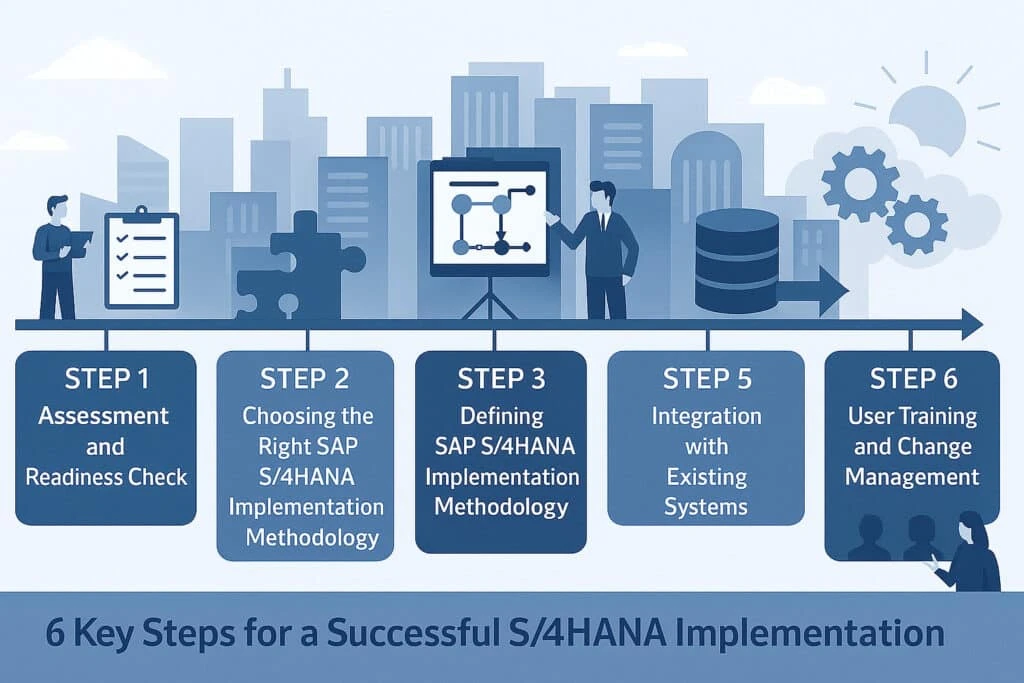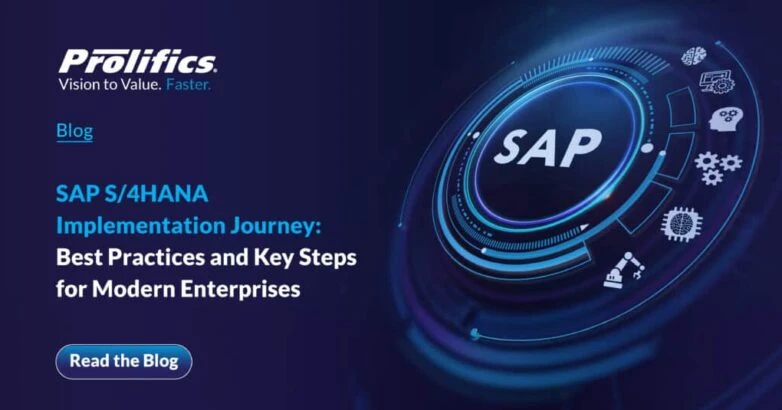As enterprises accelerate their digital transformation journeys, SAP S/4HANA Implementation has emerged as a cornerstone for modernizing enterprise resource planning (ERP). With its real-time processing capabilities, simplified data model, and advanced analytics, S/4HANA offers unprecedented business agility.
However, implementing S/4HANA is far more than a technical upgrade, it’s a strategic transformation. At Prolifics, we’ve helped global enterprises transition seamlessly to SAP S/4HANA and witnessed firsthand what drives success.
Key Steps for a Successful S/4HANA Implementation

Implementing S/4HANA requires careful planning and execution. Follow these six essential steps:
1. Assess Readiness
- Business goals
- Infrastructure compatibility
- Data quality
- Workforce skill gaps
Evaluate data quality for a smooth SAP S/4HANA migration
2. Select the Right Implementation Strategy
Choose:
- Greenfield
- Brownfield
- Hybrid
Pick the model based on your organization’s needs.
3. Define the Implementation Methodology
Use:
- SAP Activate
- Agile/DevOps
Both ensure guided and structured execution.
4. Migrate and Validate Data
Focus on:
- Extraction
- Transformation
- Integrity checks
Use automation tools to streamline SAP S/4HANA cloud migration
5. Integrate with Existing Systems
- Leverage SAP Integration Suite
- Conduct robust interface testing to ensure system compatibility
6. Train Users and Manage Change
- Implement role-specific training programs
- Apply strong change management strategies to ensure adoption
Best Practices for a Successful SAP S/4HANA Implementation
1. Establish a Clear Business Case and Vision
Many implementations fail when the focus is only on IT. S/4HANA should support broader business transformation. Successful companies define:
- A clear vision
- Measurable outcomes
These may include faster financial close, better inventory visibility, or real-time supply chain decisions.
Best Practice:
Create a business case aligned with enterprise strategy. Quantify benefits such as process optimization and operational efficiency. Involve both IT and business teams from the start.
2. Select the Right Deployment Model
SAP S/4HANA offers three deployment options – on-premise, private cloud, and public cloud – each impacting customization, cost, and governance.
Public Cloud: Simplified management and standardization for cost efficiency.
On-Premise: Maximum control and customization, but higher costs.
Private Cloud: Balanced control and scalability, ideal for regulated industries.
Best Practice:
Conduct a thorough cloud readiness and compliance assessment. At Prolifics, we help enterprises use decision frameworks to identify the optimal deployment model that aligns with operational, financial, and regulatory goals.
3. Prioritize Process Standardization
S/4HANA works best with standardized, simplified business processes. Enterprises that try to lift-and-shift legacy customizations often face delays, integration issues, and higher costs.
Best Practice:
Embrace SAP’s best practices and avoid excessive customization. Leverage the SAP Activate methodology to redesign business processes based on industry standards. Tools like SAP Signavio can help visualize and optimize processes before implementation.
4. Ensure Data Readiness and Governance
Data quality and migration are among the top causes of implementation failures. Enterprises often underestimate the effort required to cleanse, harmonize, and migrate data into the S/4HANA environment.
Best Practice:
Start data assessment early. Identify redundant, obsolete, and inconsistent data. Define ownership and governance models to maintain high-quality data. Use tools such as SAP Data Services and MDG (Master Data Governance) for accuracy and consistency. Prolifics’ proprietary data migration accelerators can further reduce complexity and risk.
5. Build a Cross-Functional Team
S/4HANA implementation touches every function—finance, supply chain, procurement, HR, and more. Successful projects are driven by a cross-functional team that includes business users, IT, change management experts, and external partners.
Best Practice:
Create a governance structure with clear roles and responsibilities. Appoint process owners from business units to co-lead the implementation alongside IT. Involve key users early in solution design, testing, and training phases to ensure adoption.
6. Adopt Agile and Iterative Delivery
Traditional waterfall models are risky for S/4HANA implementations due to the platform’s complexity and evolving scope. Agile methods offer more flexibility, allowing teams to test, validate, and iterate quickly.
Best Practice:
Break the project into manageable sprints with defined deliverables and KPIs. Use iterative prototyping and fit-gap analysis. Conduct frequent reviews with stakeholders to stay aligned with business goals. SAP’s Activate framework supports this agile delivery model effectively.
7. Invest in Change Management and Training
S/4HANA radically changes how users interact with ERP systems. From new user interfaces (SAP Fiori) to real-time dashboards, the learning curve can be steep if not managed well.
Best Practice:
Develop a comprehensive change management strategy. Communicate the “why” of the transformation to all stakeholders. Invest in role-based training, hands-on simulations, and support structures like super-user networks. Continuous learning ensures higher user adoption and productivity.
8. Enable Intelligent Insights and Automation
S/4HANA is not just a transactional system, it’s a platform for innovation. With embedded AI, machine learning, and predictive analytics, enterprises can move from reactive to proactive decision-making.
Best Practice:
Leverage built-in capabilities such as predictive accounting, demand forecasting, and AI-based anomaly detection. At Prolifics, we help clients integrate SAP S/4HANA with platforms like SAP BTP and IBM watsonx to unlock intelligent automation and enterprise-wide analytics.
9. Plan for Post-Go-Live Support
Go-live is just the beginning. Without a solid post-go-live support plan, enterprises risk facing operational disruptions, poor user experience, and delayed ROI.
Best Practice:
Establish a hypercare phase with a dedicated support team to resolve issues quickly. Monitor system performance, conduct daily standups, and implement feedback loops. After stabilization, transition to a long-term support model, ideally with a managed services provider like Prolifics.
10. Leverage the Power of Partnerships
S/4HANA is a strategic investment that requires the right ecosystem of partners. A knowledgeable implementation partner brings industry experience, proprietary tools, and accelerators that reduce time to value.
Best Practice:
Select a partner that understands both your industry and business objectives, not just the technical aspects of SAP. At Prolifics, our SAP-certified experts combine deep domain knowledge with digital innovation to drive successful S/4HANA outcomes. We offer assessment workshops, readiness checks, and tailored roadmaps for every stage of your SAP journey.
Conclusion: Future-Ready with S/4HANA
SAP S/4HANA implementation is a journey, not just a destination.
Success requires:
- Strategic alignment
- Cross-functional collaboration
- Data readiness
- Strong focus on user adoption
By following these best practices, your organization can achieve greater agility, resilience, and competitive advantage. Whether you’re exploring or ready to implement, Prolifics can help make your S/4HANA transformation future-ready.




